Pyelonephritis in Pediatric Uropathic Patients: Differences from Community-Acquired Ones and Therapeutic Protocol Considerations. A 10-Year Single-Center Retrospective Study
Abstract
1. Introduction
2. Materials and Methods
- Growth of ≥100,000 colony forming units (CFU)/mL of one uropathogen or growth of ≥100,000 CFU/mL of a uropathogen and ≤50,000 CFU/mL of a second one.
- Positivity for clinically relevant uropathogens.
- We excluded antibiograms suggestive for contamination of urine samples; the exclusion was made on the basis of the subsequent parameters:
- Growth of ≥50,000 CFU/mL of a second uropathogen or >2 organisms isolated.
- Positivity for irrelevant uropathogens.
3. Results
3.1. Not Uropathic Population (Not VUR)
3.2. Uropathic Population (VUR)
4. Discussion
- AMP: 100–200 mg/Kg divided in 3–4 doses daily.
- CAZ: 100–150 mg/Kg divided in 2–3 doses daily.
5. Conclusions
Author Contributions
Funding
Institutional Review Board Statement
Informed Consent Statement
Data Availability Statement
Conflicts of Interest
References
- Freedman, A.L. Urologic disease in North America Project: Trends in resource utilization for urinary tract infections in children. J. Urol. 2005, 173, 949–954. [Google Scholar] [CrossRef] [PubMed]
- Larcombe, J. Urinary tract infection in children. BMJ Clin Evid. 2010, 2010. [Google Scholar]
- Chang, S.L.; Shortliffe, L.D. Pediatric urinary tract infections. Pediatr. Clin. 2006, 53, 379–400. [Google Scholar] [CrossRef]
- Sarvis, A.B.; Sarvis, R.C.; Schnadower, D.; Chamberlain, J.M.; Mathison, D.J. Admit Versus Discharge-A Cost Analysis of Infants 29 to 60 Days Old with Febrile Urinary Tract Infection at Low Risk for Bacteremia. Acad. Pediatr. 2019, 19, 209–215. [Google Scholar] [CrossRef]
- Shaikh, N.; Mattoo, T.K.; Keren, R.; Ivanova, A.; Cui, G.; Moxey-Mims, M.; Majd, M.; Ziessman, H.A.; Hoberman, A. Early Antibiotic Treatment for Pediatric Febrile Urinary Tract Infection and Renal Scarring. JAMA Pediatr. 2016, 170, 848–854. [Google Scholar] [CrossRef]
- Hewitt, I.K.; Zucchetta, P.; Rigon, L.; Maschio, F.; Molinari, P.P.; Tomasi, L.; Toffolo, A.; Pavanello, L.; Crivellaro, C.; Bellato, S.; et al. Early treatment of acute pyelonephritis in children fails to reduce renal scarring: Data from the Italian Renal Infection Study Trials. Pediatrics 2008, 122, 486–490. [Google Scholar] [CrossRef]
- Doganis, D.; Siafas, K.; Mavrikou, M.; Issaris, G.; Martirosova, A.; Perperidis, G.; Konstantopoulos, A.; Sinaniotis, K. Does early treatment of urinary tract infection prevent renal damage? Pediatrics 2007, 120, e922–e928. [Google Scholar] [CrossRef]
- Strohmeier, Y.; Hodson, E.M.; Willis, N.S.; Webster, A.C.; Craig, J.C. Antibiotics for acute pyelonephritis in children. Cochrane Database Syst. Rev. 2014. [Google Scholar] [CrossRef] [PubMed]
- Hoberman, A.; Wald, E.R.; Hickey, R.W.; Baskin, M.; Charron, M.; Majd, M.; Kearney, D.H.; Reynolds, E.A.; Ruley, J.; Janosky, J.E. Oral versus initial intravenous therapy for urinary tract infections in young febrile children. Pediatrics 1999, 104, 79–86. [Google Scholar] [CrossRef] [PubMed]
- Edlin, R.S.; Shapiro, D.J.; Hersh, A.L.; Copp, H.L. Antibiotic resistance patterns of outpatient pediatric urinary tract infections. J. Urol. 2013, 190, 222–227. [Google Scholar] [CrossRef]
- Yakubov, R.; van den Akker, M.; Machamad, K.; Hochberg, A.; Nadir, E.; Klein, A. Antimicrobial Resistance Among Uropathogens That Cause Childhood Community-acquired Urinary Tract Infections in Central Israel. Pediatr. Infect. Dis. J. 2017, 36, 113–115. [Google Scholar] [CrossRef]
- Shaikh, N.; Hoberman, A.; Keren, R.; Ivanova, A.; Gotman, N.; Chesney, R.W.; Carpenter, M.A.; Moxey-Mims, M.; Wald, E.R. Predictors of Antimicrobial Resistance among Pathogens Causing Urinary Tract Infection in Children. J. Pediatr. 2016, 171, 116–121. [Google Scholar] [CrossRef]
- Bryce, A.; Hay, A.D.; Lane, I.F.; Thornton, H.V.; Wootton, M.; Costelloe, C. Global prevalence of antibiotic resistance in paediatric urinary tract infections caused by Escherichia coli and association with routine use of antibiotics in primary care: Systematic review and meta-analysis. BMJ 2016, 352, i939. [Google Scholar] [CrossRef]
- Subcommittee on Urinary Tract Infection; Steering Committee on Quality Improvement and Management. Urinary Tract infection: Clinical practice guidelines for the diagnosis and management of the initial UTI in febrile infants and children 2 to 24 months. Pediatrics 2011, 128, 595–610. [Google Scholar] [CrossRef] [PubMed]
- Selekman, R.E.; Shapiro, D.J.; Boscardin, J.; Williams, G.; Craig, J.C.; Brandström, P.; Pennesi, M.; Roussey-Kesler, G.; Hari, P.; Copp, H.L. Uropathogen Resistance and Antibiotic Prophylaxis: A Meta-analysis. Pediatrics. 2018, 142, e20180119. [Google Scholar] [CrossRef] [PubMed]
- Shaikh, N.; Morone, N.E.; Lopez, J.; Chianese, J.; Sangvai, S.; D’Amico, F.; Hoberman, A.; Wald, E.R. Does this child have a urinary tract infection? JAMA 2007, 298, 2895–2904. [Google Scholar] [CrossRef] [PubMed]
- Shaikh, N.; Hoberman, A.; Hum, S.W.; Alberty, A.; Muniz, G.; Kurs-Lasky, M.; Landsittel, D.; Shope, T. Development and Validation of a Calculator for Estimating the Probability of Urinary Tract Infection in Young Febrile Children. JAMA Pediatr. 2018, 172, 550–556. [Google Scholar] [CrossRef]
- Whiteside, S.A.; Razvi, H.; Dave, S.; Reid, G.; Burton, J.P. The microbiome of the urinary tract--a role beyond infection. Nat. Rev. Urol. 2015, 12, 81–90. [Google Scholar] [CrossRef] [PubMed]
- Kline, K.A.; Lewis, A.L. Gram-Positive Uropathogens, Polymicrobial Urinary Tract Infection, and the Emerging Microbiota of the Urinary Tract. Microbiol. Spectr. 2016, 4. [Google Scholar] [CrossRef] [PubMed]
- Karstens, L.; Asquith, M.; Caruso, V.; Rosenbaum, J.T.; Fair, D.A.; Braun, J.; Gregory, W.T.; Nardos, R.; McWeeney, S.K. Community profiling of the urinary microbiota: Considerations for low-biomass samples. Nat. Rev. Urol. 2018, 15, 735–749. [Google Scholar] [CrossRef]
- Bi, H.; Tian, Y.; Song, C.; Li, J.; Liu, T.; Chen, Z.; Chen, C.; Huang, Y.; Zhang, Y. Urinary microbiota—A potential biomarker and therapeutic target for bladder cancer. J. Med. Microbiol. 2019, 68, 1471–1478. [Google Scholar] [CrossRef]
- Wu, P.; Zhang, G.; Zhao, J.; Chen, J.; Chen, Y.; Huang, W.; Zhong, J.; Zeng, J. Profiling the Urinary Microbiota in Male Patients with Bladder Cancer in China. Front. Cell. Infect. Microbiol. 2018, 8, 167. [Google Scholar] [CrossRef]
- Bajic, P.; Wolfe, A.J.; Gupta, G.N. The Urinary Microbiome: Implications in Bladder Cancer Pathogenesis and Therapeutics. Urology 2019, 126, 10–15. [Google Scholar] [CrossRef] [PubMed]
- Zeng, J.; Zhang, G.; Chen, C.; Li, K.; Wen, Y.; Zhao, J.; Wu, P. Alterations in Urobiome in Patients With Bladder Cancer and Implications for Clinical Outcome: A Single-Institution Study. Front. Cell. Infect. Microbiol. 2020, 10, 784. [Google Scholar] [CrossRef] [PubMed]
- Wu, P.; Chen, Y.; Zhao, J.; Zhang, G.; Chen, J.; Wang, J.; Zhang, H. Urinary Microbiome and Psychological Factors in Women with Overactive Bladder. Front. Cell. Infect. Microbiol. 2017, 7, 488. [Google Scholar] [CrossRef] [PubMed]
- Khan, A.; Miller, W.R.; Arias, C.A. Mechanisms of antimicrobial resistance among hospital-associated pathogens. Expert Rev. Anti-Infect. Ther. 2018, 16, 269–287. [Google Scholar] [CrossRef]
- Hidron, A.I.; Edwards, J.R.; Patel, J.; Horan, T.C.; Sievert, D.M.; Pollock, D.A.; Fridkin, S.K. NHSN annual update: Antimicrobial-resistant pathogens associated with healthcare-associated infections: Annual summary of data reported to the National Healthcare Safety Network at the Centers for Disease Control and Prevention, 2006–2007. Infect. Control Hosp. Epidemiol. 2008, 29, 996–1011. [Google Scholar] [CrossRef]
- Menichetti, F.; Tagliaferri, E. Antimicrobial resistance in internal medicine wards. Intern. Emerg. Med. 2012, 7, 271–281. [Google Scholar] [CrossRef]
- Wang, H.P.; Zhang, H.J.; Liu, J.; Dong, Q.; Duan, S.; Ge, J.-Q.; Wang, Z.-H.; Zhang, Z. Antimicrobial resistance of 3 types of gram-negative bacteria isolated from hospital surfaces and the hands of health care workers. Am. J. Infect. Control 2017, 45, e143–e147. [Google Scholar] [CrossRef]
- Meyer, E.; Schwab, F.; Jonas, D.; Ruden, H.; Gastmeier, P.; Daschner, F.D. Temporal changes in bacterial resistance in German intensive care units, 2001–2003: Data from the SARI (surveillance of antimicrobial use and antimicrobial resistance in intensive care units) project. J. Hosp. Infect. 2005, 60, 348–352. [Google Scholar] [CrossRef]
- Wong, P.H.; von Krosigk, M.; Roscoe, D.L.; Lau, T.T.; Yousefi, M.; Bowie, W.R. Antimicrobial co-resistance patterns of gram-negative bacilli isolated from bloodstream infections: A longitudinal epidemiological study from 2002–2011. BMC Infect. Dis. 2014, 14, 1–10. [Google Scholar] [CrossRef]
- Wise, E.M., Jr.; Abou-Donia, M.M. Sulfonamide resistance mechanism in Escherichia coli: R plasmids can determine sulfonamide-resistant dihydropteroate synthases. Proc. Natl. Acad. Sci. USA 1975, 72, 2621–2625. [Google Scholar] [CrossRef]
- Muloi, D.; Kiiru, J.; Ward, M.J.; Hassell, J.M.; Bettridge, J.M.; Robinson, T.P.; van Bunnik, B.A.D.; Chase-Topping, M.; Robertson, G.; Pedersen, A.B. Epidemiology of antimicrobial-resistant Escherichia coli carriage in sympatric humans and livestock in a rapidly urbanizing city. Int. J. Antimicrob. Agents 2019, 54, 531–537. [Google Scholar] [CrossRef]
- Manges, A.R.; Dietrich, P.S.; Riley, L.W. Multidrug-resistant Escherichia coli clonal groups causing community-acquired pyelonephritis. Clin. Infect. Dis. 2004, 38, 329–334. [Google Scholar] [CrossRef] [PubMed]
- Manges, A.R.; Perdreau-Remington, F.; Solberg, O.; Riley, L.W. Multidrug-resistant Escherichia coli clonal groups causing community-acquired bloodstream infections. J. Infect. 2006, 53, 25–29. [Google Scholar] [CrossRef]
- Ejrnæs, K. Bacterial characteristics of importance for recurrent urinary tract infections caused by Escherichia coli. Dan. Med. Bull. 2011, 58, B4187. [Google Scholar] [PubMed]
- Lee, J.N.; Byeon, K.H.; Woo, M.J.; Baek, H.S.; Cho, M.H.; Jeong, S.Y.; Lee, S.M.; Ham, J.Y.; Ha, Y.; Kim, H.T.; et al. Susceptibility of the Index Urinary Tract Infection to Prophylactic Antibiotics Is a Predictive Factor of Breakthrough Urinary Tract Infection in Children with Primary Vesicoureteral Reflux Receiving Continuous Antibiotic Prophylaxis. J. Korean Med. Sci. 2019, 34, e156. [Google Scholar] [CrossRef]
- Raimund, S.; Dogan, H.S.; Hoebeke, P.; Kočvara, R.; Nijman, R.J.M.; Radmayr, C.; Tekgü, S. Urinary Tract Infections in Children: EAU/ESPU Guidelines. Eur. Urol. 2015, 67, 546–558. [Google Scholar]
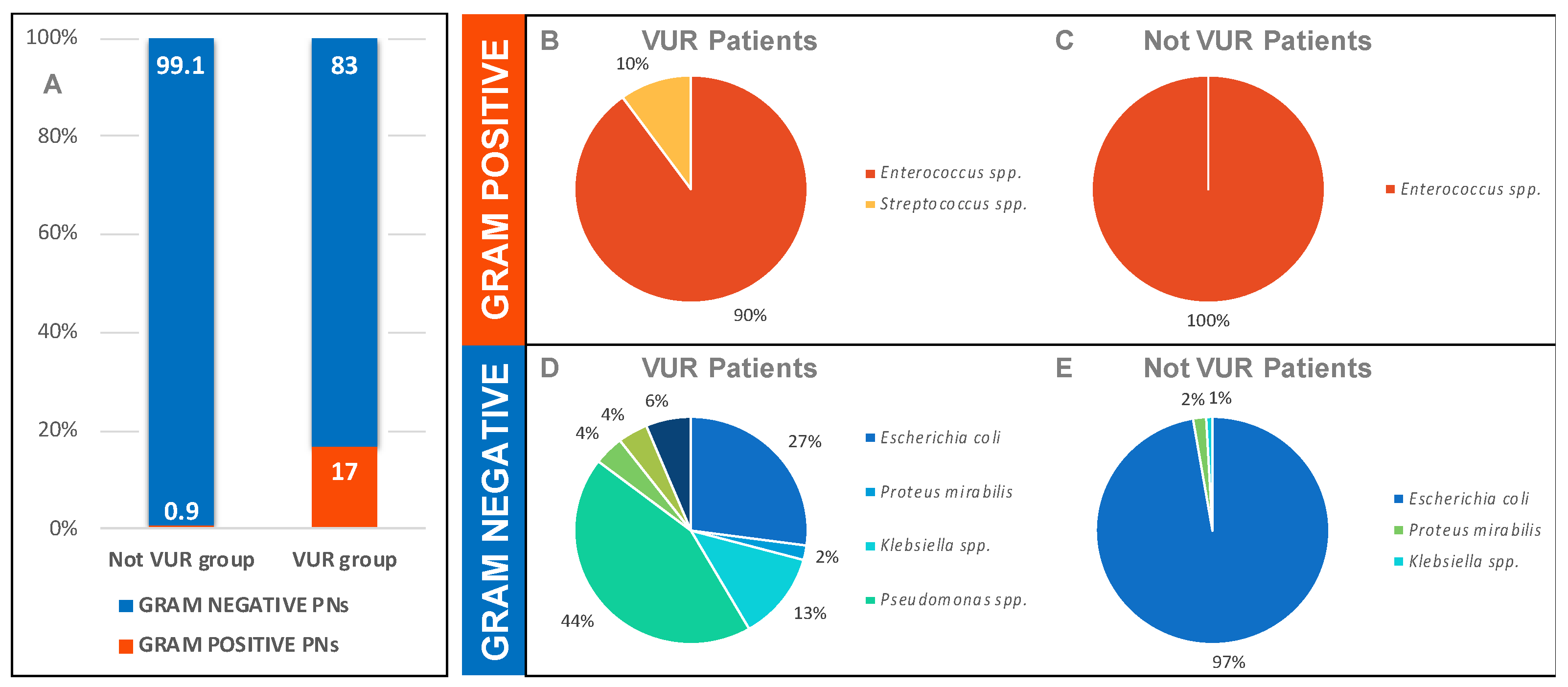
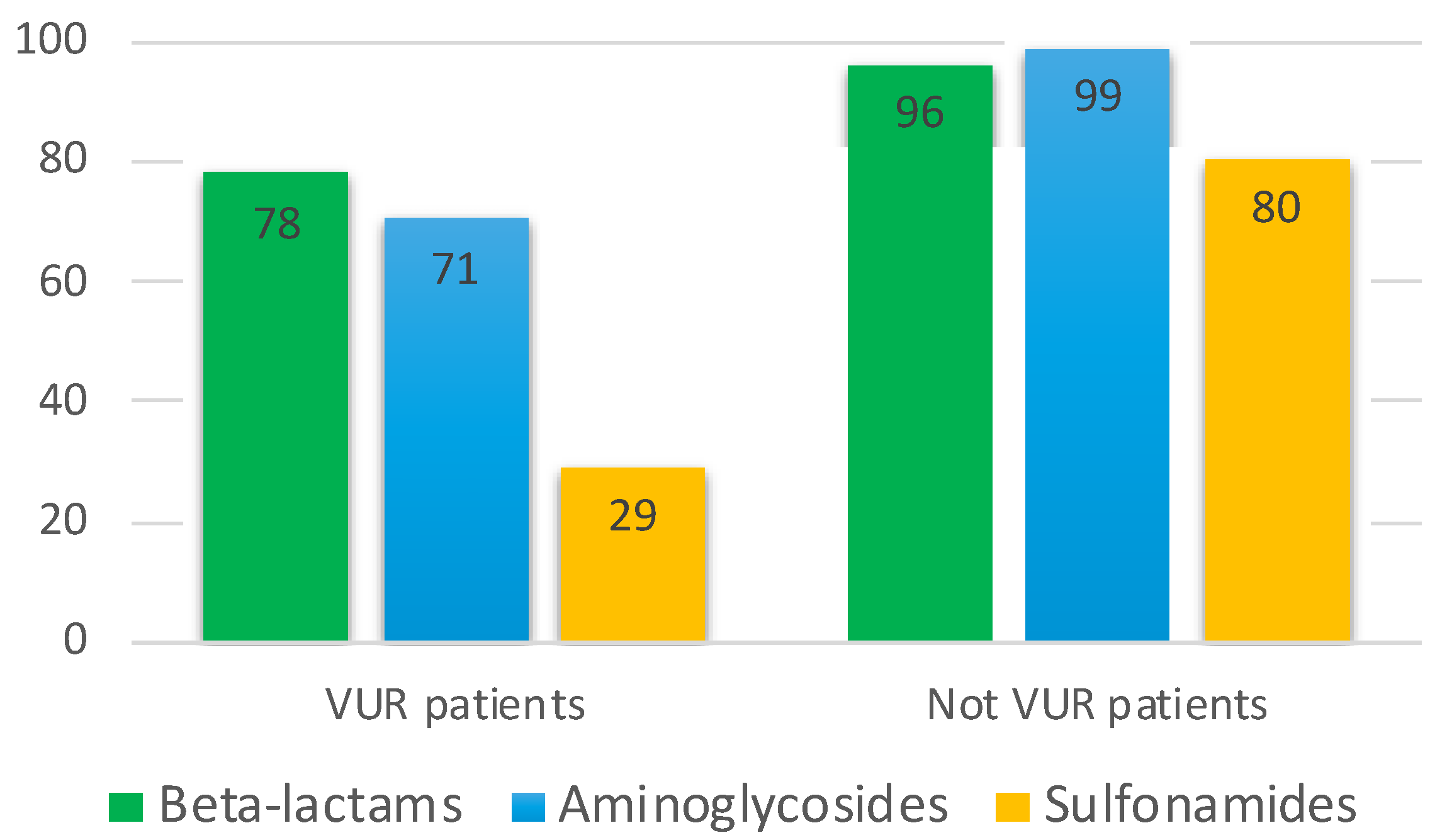
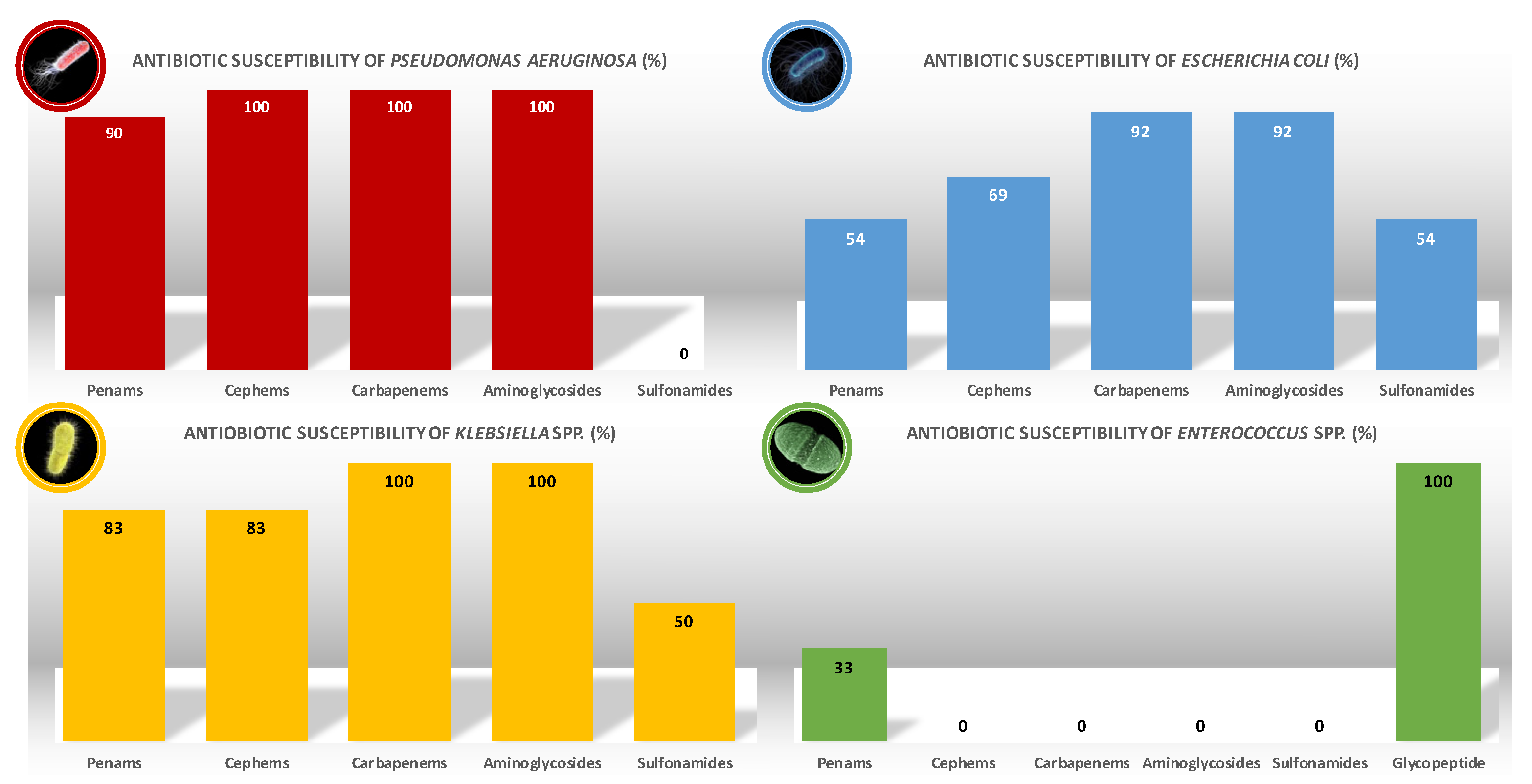
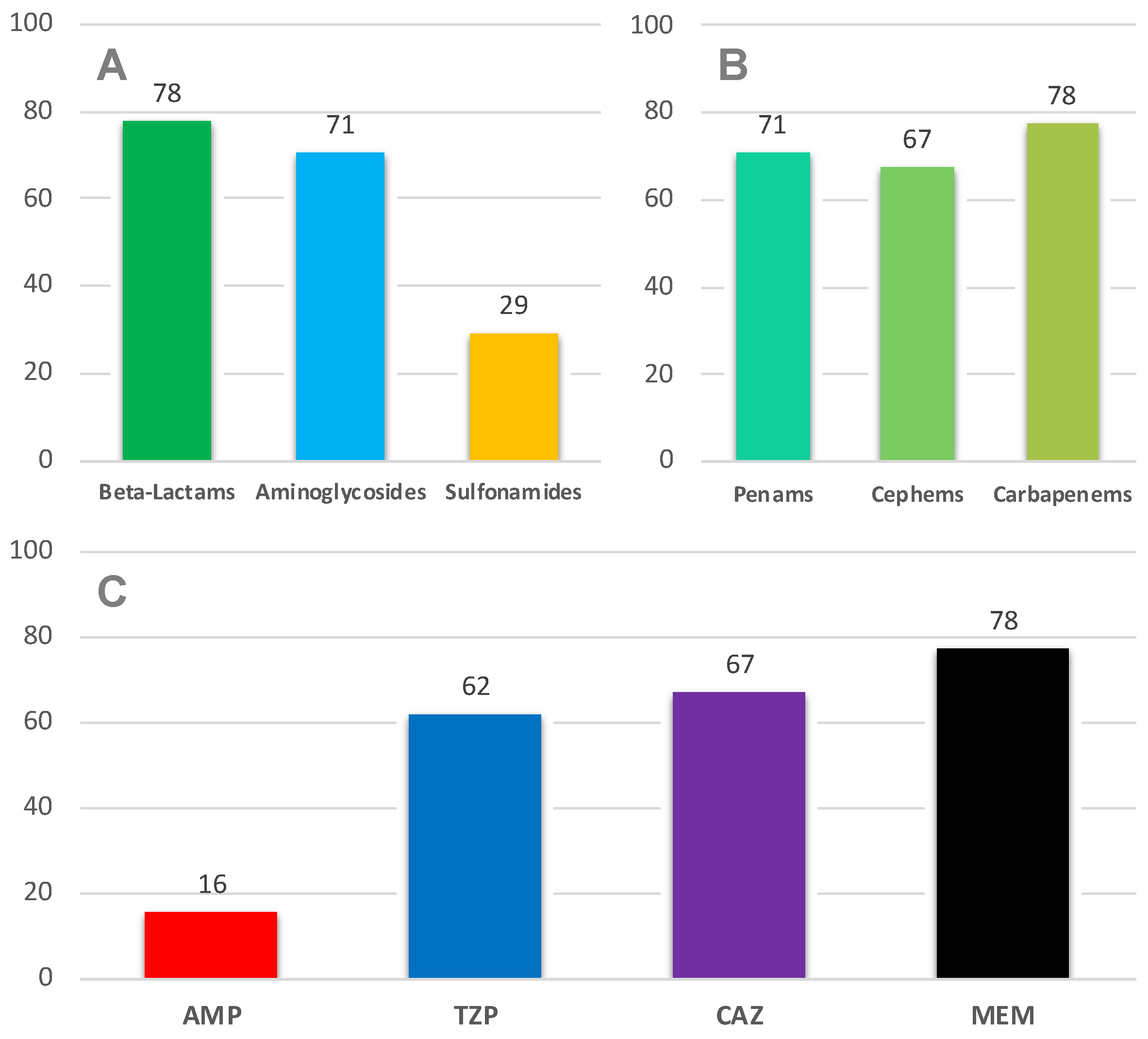
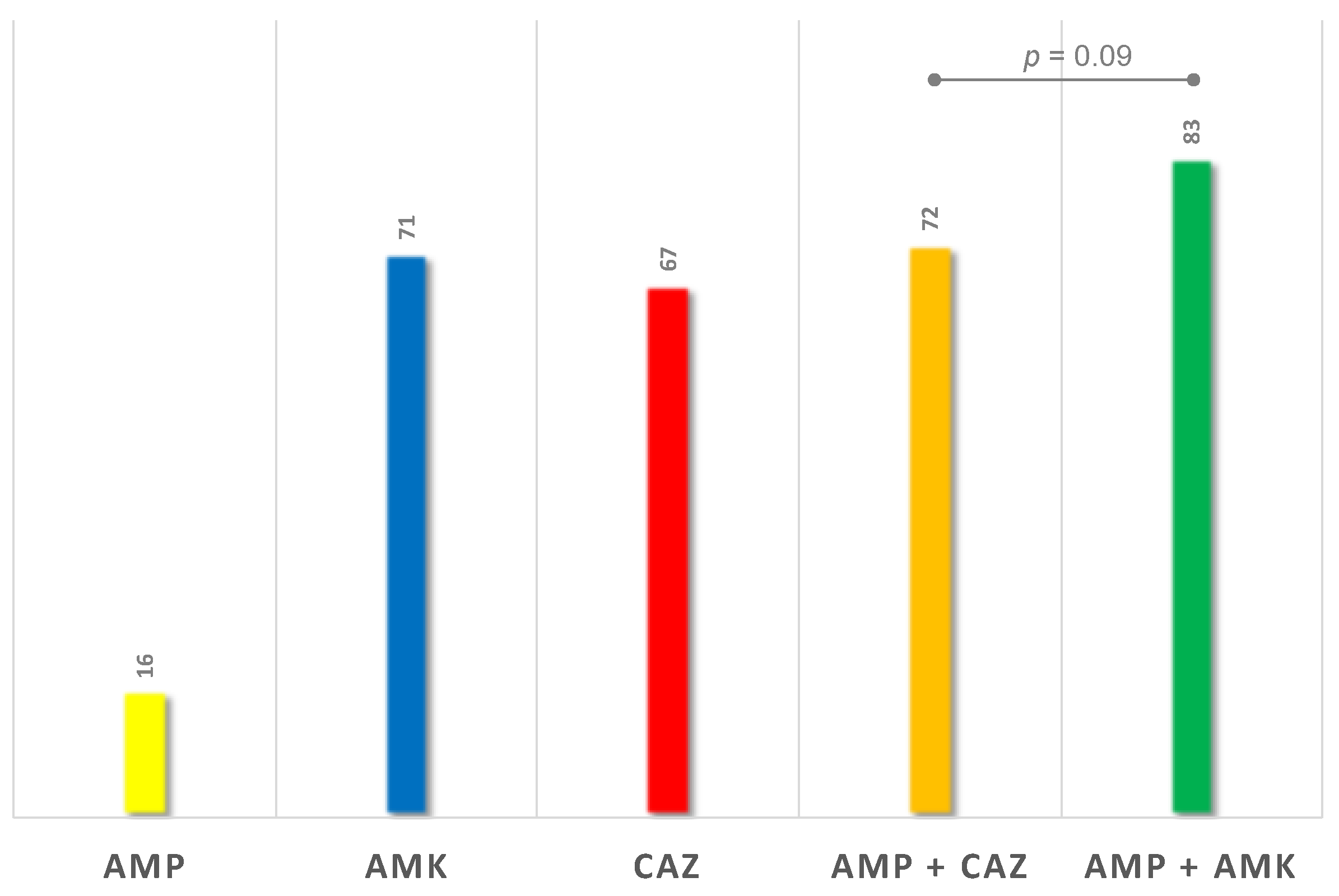
Publisher’s Note: MDPI stays neutral with regard to jurisdictional claims in published maps and institutional affiliations. |
© 2021 by the authors. Licensee MDPI, Basel, Switzerland. This article is an open access article distributed under the terms and conditions of the Creative Commons Attribution (CC BY) license (https://creativecommons.org/licenses/by/4.0/).
Share and Cite
Parente, G.; Gargano, T.; Pavia, S.; Cordola, C.; Vastano, M.; Baccelli, F.; Gallotta, G.; Bruni, L.; Corvaglia, A.; Lima, M. Pyelonephritis in Pediatric Uropathic Patients: Differences from Community-Acquired Ones and Therapeutic Protocol Considerations. A 10-Year Single-Center Retrospective Study. Children 2021, 8, 436. https://doi.org/10.3390/children8060436
Parente G, Gargano T, Pavia S, Cordola C, Vastano M, Baccelli F, Gallotta G, Bruni L, Corvaglia A, Lima M. Pyelonephritis in Pediatric Uropathic Patients: Differences from Community-Acquired Ones and Therapeutic Protocol Considerations. A 10-Year Single-Center Retrospective Study. Children. 2021; 8(6):436. https://doi.org/10.3390/children8060436
Chicago/Turabian StyleParente, Giovanni, Tommaso Gargano, Stefania Pavia, Chiara Cordola, Marzia Vastano, Francesco Baccelli, Giulia Gallotta, Laura Bruni, Adelaide Corvaglia, and Mario Lima. 2021. "Pyelonephritis in Pediatric Uropathic Patients: Differences from Community-Acquired Ones and Therapeutic Protocol Considerations. A 10-Year Single-Center Retrospective Study" Children 8, no. 6: 436. https://doi.org/10.3390/children8060436
APA StyleParente, G., Gargano, T., Pavia, S., Cordola, C., Vastano, M., Baccelli, F., Gallotta, G., Bruni, L., Corvaglia, A., & Lima, M. (2021). Pyelonephritis in Pediatric Uropathic Patients: Differences from Community-Acquired Ones and Therapeutic Protocol Considerations. A 10-Year Single-Center Retrospective Study. Children, 8(6), 436. https://doi.org/10.3390/children8060436







